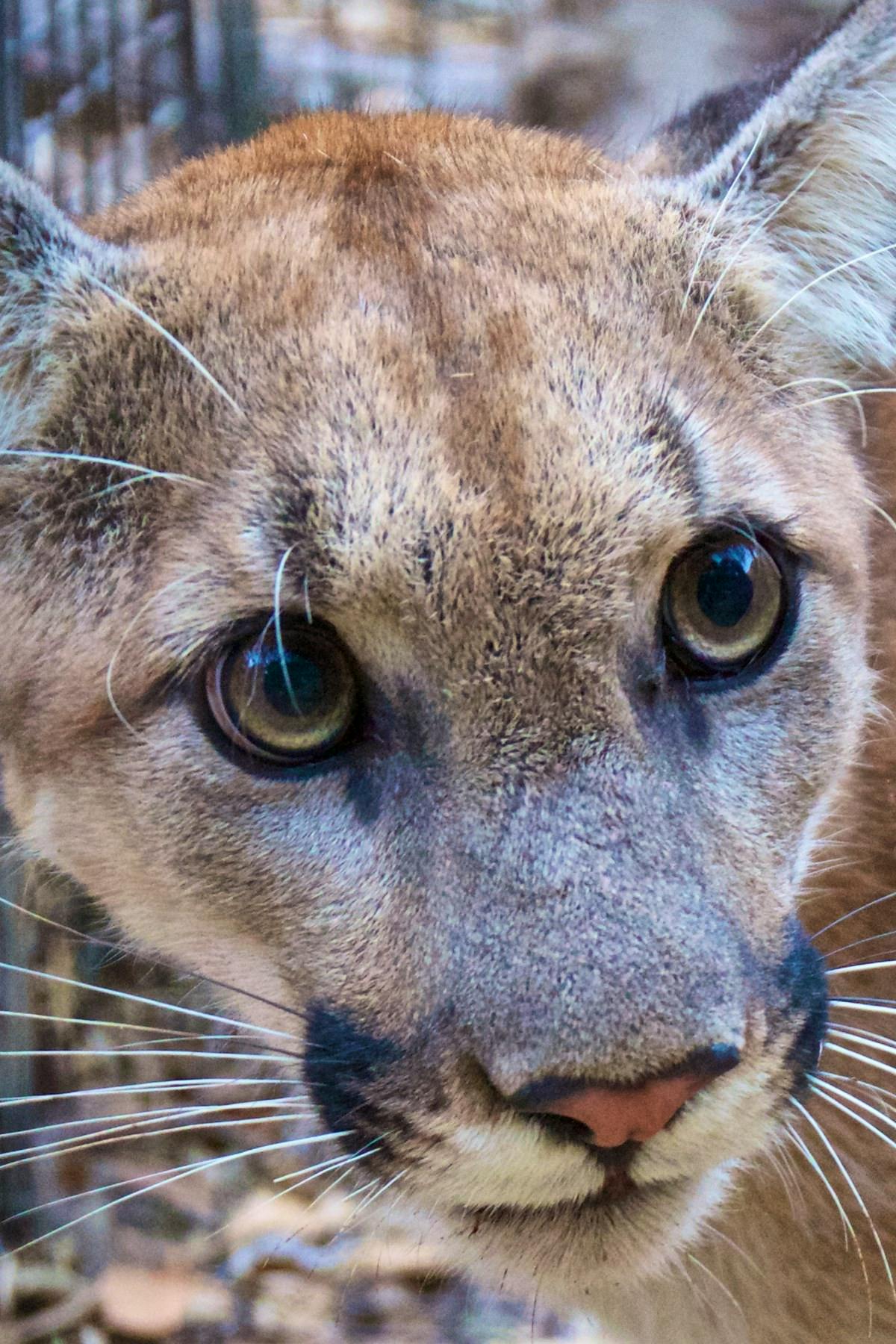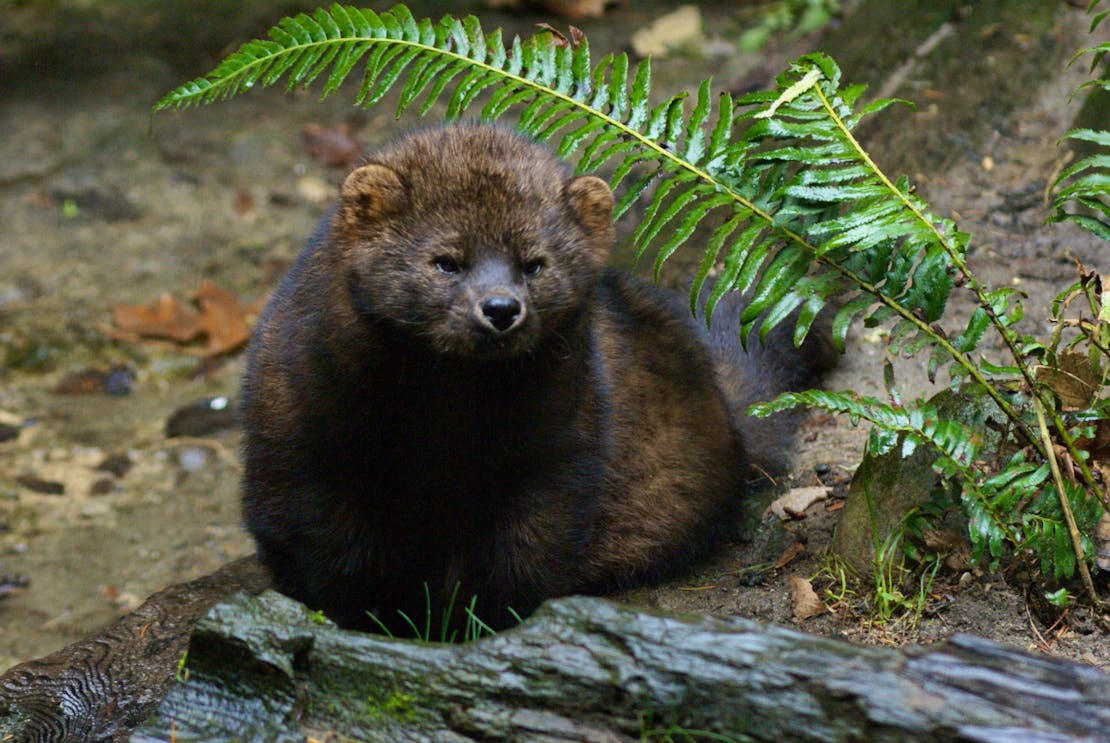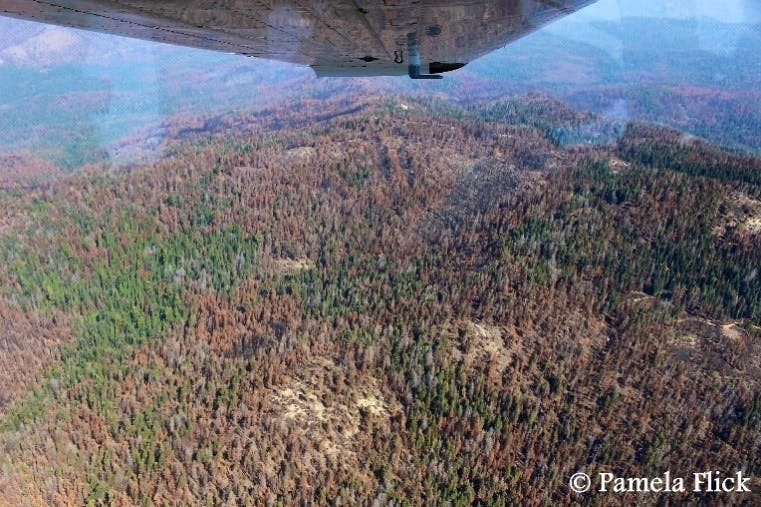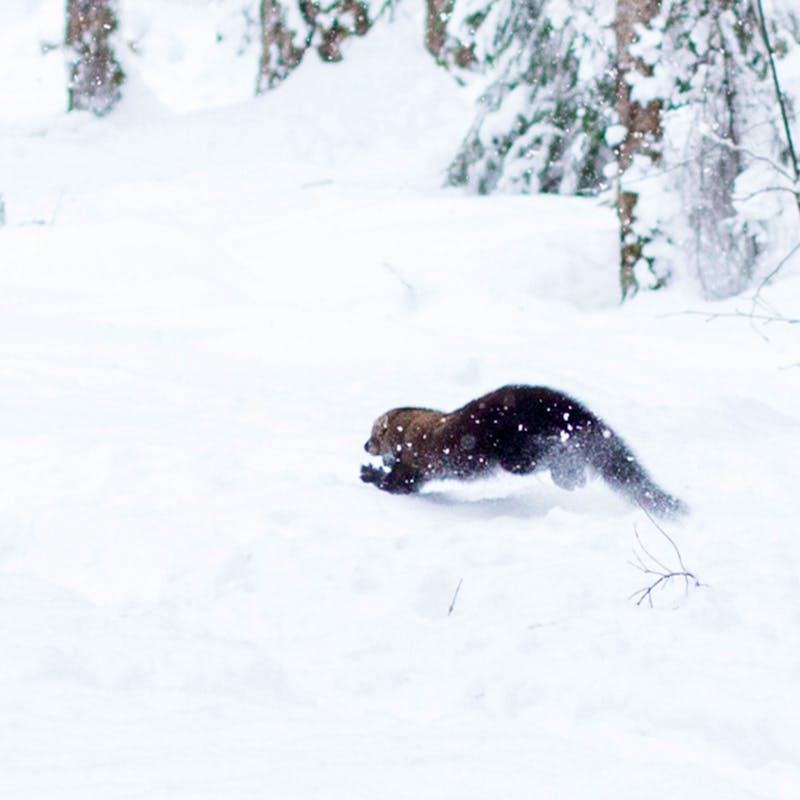Making the Golden State more resilient for people and wildlife
Californians have endured yet another year of uncharacteristically severe and damaging wildfires up and down our state. Notably, the Camp Fire in Butte County left in its wake square miles of ash, melted metal, and scorched debris, blackening more than 153,000 acres, wiping entire towns off the map and blanketing much of California in a thick blanket of toxic air. The scale of loss in Paradise and its neighboring communities is as staggering as it is unimaginable. The latest numbers from this single fire are simply unfathomable: nearly 14,000 homes destroyed, 86 confirmed human deaths, and countless animals perished in the mercilessly fast-moving fire that ignited on the morning of November 8th in the nearby Feather River Canyon. More than 120 people remain missing or otherwise unaccounted for at the time of publishing.
While we at Defenders have long supported fire’s role in providing essential benefits and promoting resilience for our natural lands, there is no denying that the losses to human communities from California’s wildfires in the past few years have been some of the worst ever. The level of devastation from the Camp Fire alone is completely heartbreaking, especially in this area so familiar to Defenders’ California Program team. Just a few months ago, our California Director attended the California Department of Fish and Wildlife (CDFW) Wildlife Officer Academy Ceremony in Paradise to celebrate the graduation of 32 new wildlife officers. Sadly, more than 20 CDFW staff members and their families have been affected by the Camp Fire.
Earlier this year, I had the opportunity to better know this charming town perched atop the ridge east of Chico through a fencing project to protect both black bears and Noble Orchards, which has operated in Paradise for 97 years. Unfortunately, we recently got confirmation that all 11 buildings at Noble Orchards have been destroyed. A glimmer of hope remains in the green leaves of some unscathed fruit trees. Still the future remains uncertain, not only for the Nobles, but for the thousands upon thousands of families who lost everything but the clothes on their backs.


As the Camp Fire was burning in northern California, the Santa Monica Mountains above Malibu in southern California were ablaze in the Woolsey Fire. Nearly 100,000 acres burned there, destroying 1,500 structures and killing three people. One of the few known mountain lions that call this area home, known as P-74, is also believed to have perished in this fire. His GPS collar last sent a signal at 1pm on November 9th, but failed to register at the next automatic check-in, at 5pm that same day. Biologists shared that the fire came through the area that was P-74’s last known location. Before people moved into their habitat, mountain lions like P-74 may have been able to escape the flames. Under historical conditions, a fire might have benefited this lion by making prey more visible and attracting prey to new forage regenerating after the burn.
California’s wildfires have become more destructive for people and wildlife.
The Camp Fire has become the most destructive and deadliest in California’s history. This summer’s Mendocino Complex was the largest ever recorded in our state at nearly 460,000 acres, taking that distinction from the Thomas Fire, which burned more than 281,000 acres just last December in Ventura and Santa Barbara counties. You read that right — prior to this year, California’s largest fire burned in December! Three of the five most destructive fires to ever occur in the Golden State have happened in northern California in just the past three years.
Why have California’s fires become so intense in recent years? It’s a complex issue that melds past and current land management actions, human development patterns and the effects of our changing climate, among other things. In the past, unsustainable logging practices removed the largest, most fire-resistant trees from many of our forests, leaving smaller trees and brush that serve as ladders to move fires from forest floor to canopy. Once a fire advances from treetop to treetop, known as a crown fire, it can move very rapidly and cause high-severity fires that kill many trees. More than a century of aggressive fire suppression policies dampened the role of fire within our fire-adapted ecosystems. This has changed what grows in the forest and where it grows, which in turn affects how fires move across the landscape.
Making things worse, climate change is having a profound effect on wildlife and habitats across the globe, and California is no exception. We are seeing significant changes in rain and snow patterns, with less snow and earlier snowmelt. California’s most recent drought ended after five years in April 2017. However, some regions of California remain in drought status. While California is currently not officially in a declared drought, many parts of our state, including the area struck by the Camp Fire, have experienced a prolonged period of extremely dry conditions this year. Longer dry seasons leave parched vegetation that readily carries fire rapidly through grasslands, brush fields or forests — and as we’ve seen more and more, through entire neighborhoods.
We can’t — and shouldn’t — simply increase logging to solve this problem.
The Trump Administration has been quick to blame forest mismanagement for our recent disasters, insisting that ramping up large-scale logging is the simple solution to this complicated problem, but this rhetoric ignores two important facts. First, fire scientists have concluded that increased logging will not fix the problem and could make it worse. Second, many of our most recent big fires have burned in areas outside of forests, in places dominated by brush or grassland habitats. Our state has the largest human population in the entire nation, nearly tripling in the last half of the 20th century. California’s metropolitan areas are home to tens of millions of people, but human development has continually expanded in what’s commonly referred to as the Wildland Urban Interface (WUI). The WUI is where homes and wildland vegetation are interspersed and where wildfire dangers are most pronounced. In some areas, inadequate routes to get people out of harm’s way and emergency responders closer to fires, increase the danger, as was the case in the Camp Fire.
What’s needed to make sure people and wildlife are not threatened by future wildfires?
First, few in California disagree that we must increase investments at all levels to address the growing threat of wildfire to our human and natural communities. We must increase the pace and scale of forest treatments, including controlled burns, and focus on removing the most problematic vegetation — small diameter trees and brush — and not the large, most fire-resistant trees. We need to create incentives that result in economically viable markets for the small diameter trees and brush that are removed from these lands. Historically, smaller trees and brush have been considered waste, while the removal of the largest trees destroy the most important habitat for imperiled wildlife like Pacific fisher, California spotted owl, and northern goshawk.
Second, we must focus on making human communities in the WUI more fire resilient. We must ensure that homes located within the WUI are “hardened” through use of fire-proof roofing materials, installation of metal mesh screening on all eaves and attic vents to prevent ember intrusion, clearing rooftops and gutters of dead leaves, pine needles, or other debris, removal of all flammable materials from exterior walls and from under decks and porches, and maintenance of at least 100 feet of defensible space around homes and other structures. You can learn more about how to prepare your home for wildfire or work with your neighbors to have your community recognized as a Firewise USA site. New housing developments in the WUI should also be discouraged if they are not resilient to wildfire. The less we build in high fire hazard areas, the lower our risk of burning down new homes.
Finally, we must increase the ability of our wild areas to better withstand future wildfires and droughts. Healthy landscapes provide plentiful habitat for our wildlife species to thrive. As climate change increasingly impacts fish and wildlife, functional and intact wildlands will become even more critical to the future survival of wolves, bears, mountain lions, fishers, and all other species that benefit from natural fire patterns.
To increase resiliency and reduce potential for future wildfires, we must restore fire to our fire-adapted ecosystems when and where it is safe to do so. These lands evolved with fire for eons and it’s more critical than ever that we reestablish natural fire regimes to our natural areas. More than a century of putting out all fires have left unnatural conditions leaving forests prone to more destructive wildfires. If we proactively ramp up the use of controlled fire as a restoration tool, we can remove the dense vegetation that fuels fast-moving blazes, giving fire crews better opportunities to stop future wildfires.
There is growing understanding and acceptance of the trade-offs between uncontrolled wildfire smoke outputs and emissions from controlled, prescribed fire done at the right time, in right place, under the right conditions. One only needs to look at the Rim Fire in 2013, which just five years ago was California’s third largest fire on record and remains the largest fire in the Sierra Nevada region at more than a quarter million acres. The smoke plume from the Rim Fire stretched from the central Sierra all the way to central Canada and spewed the equivalent to the annual carbon dioxide emissions of 2.57 million cars, sending us backwards on our ambitious goal to reduce California’s greenhouse gas emissions to 1990 levels by 2030. Restoring older forests and reestablishing more natural fire patterns can keep carbon sequestered in our forests.
Defenders has been on the front lines of forestry and fire issues in California for years.
I have been an active participant in the Sierra National Forest’s Dinkey Landscape Restoration Project, one of the first projects approved under the Forest Service’s Collaborative Forest Landscape Restoration Program. Passed in 2009, the purpose of this innovative federal program “is to encourage the collaborative, science-based ecosystem restoration of priority forest landscapes.” The Dinkey Collaborative brings together varied stakeholders — including representatives of the timber industry, off-road vehicle enthusiasts, environmentalists, local landowners and others — to work alongside Forest Service specialists to identify priority projects for forest restoration work, including forest thinning projects and prescribed burning to reduce fuels in the forest near Shaver Lake, a mountain community northeast of Fresno. We are moving forward — together — to advance forest and community resiliency.
I have also served as a founding steering committee member of the Southern Sierra Prescribed Fire Council (SSPFC) since its inception. The SSPFC serves as a venue for fire specialists, state and federal land management agencies, academic institutions, tribes, conservation organizations and other interested parties to work together to promote, protect, conserve, and expand the responsible use of prescribed fire and cultural fire in the southern Sierra Nevada’s fire-adapted landscapes. The SSPFC also works to promote public understanding and acceptance of the ecological and cultural importance of burning.
Another important effort is the Fire MOU Partnership, which Defenders joined this year. The Fire MOU Partnership brings together interested parties to increase the use of managed fire for ecological and other resource benefits. The term “managed fire” includes both planned fires like those conducted through controlled burns, as well as natural ignitions by lightning strikes. The Partnership now includes more than 30 signatories, including federal and state land management agencies, air quality control districts, conservation organizations, the timber industry, prescribed fire councils and others, all dedicated to creating landscapes that are resilient to the effects of climate change and reducing risks to human communities near wildlands. Read the Fire MOU here.
In addition to all these collaborative efforts, we regularly reach out to elected officials to make meaningful policy changes. We work through traditional media outlets and social media platforms to raise public awareness about the challenges and opportunities that lie ahead in addressing this critical issue facing our state. We’ve even taken to the skies through EcoFlight to get a birds-eye view of recent fires and their effects on the landscape in the Sierra Nevada, which helps inform our advocacy and outreach efforts.
Just this month, we met with fire specialists and leadership from the Forest Service and National Park Service to discuss the effects of the Ferguson Fire that burned this summer in Mariposa County on the Sierra National Forest and then into Yosemite National Park. This one was particularly personal to me in several ways. I was raised in Mariposa and this fire burned through many special places in my beloved stomping grounds, including the vast South Fork inventoried roadless area, which could be recommended for future wilderness designation. The Ferguson Fire burned in an area that wildlife biologists believe is critically important for the conservation of the imperiled fisher here at the northern edge of the species’ range in the southern Sierra, including what is believed to the corridor used by a single male fisher to cross the Merced River, making him the first known fisher north of the Merced River canyon since 1920. The good news is that while some areas burned severely, such as that shown in the photo below, much of the fire burned in a way that was beneficial to the landscape and reduced fuels to help moderate potential future fires in the area.
Earlier this year, we worked in the State Legislature to pass commonsense laws to bolster state investments for fuels reduction and prescribed fire use by $1 billion and to increase the focus on wildfire hazard planning for human communities, among other positive fire-related outcomes. Defenders also continues our important work on fire and public land management policy at the national level through our staff’s diligent work out of our headquarters in Washington, DC — because these complex issues require an “all hands on deck” approach.
For those who have been affected by California’s recent wildfires, Defenders extends our deepest sympathy. We will work tirelessly in the Sierra, in Sacramento, and in Washington, DC, to make sure that there is the planning, policies, and funding in place to improve how we manage our natural lands to better conserve wildlife and habitat while we protect human communities. We must take all steps we can to address and slow the effects of climate change, minimize future losses of lives and property, and lessen harm to our natural lands and wildlife.















